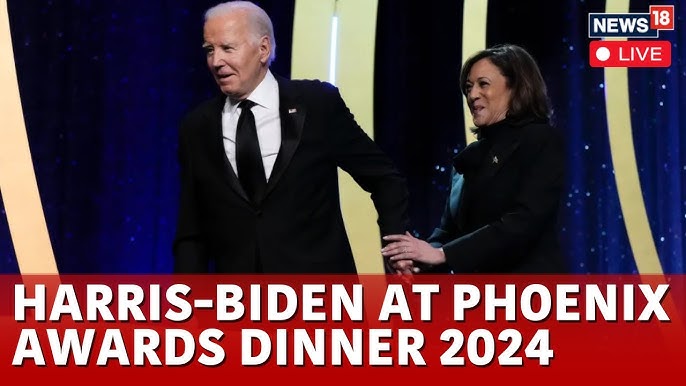At a recent 2024 Phoenix Awards dinner in Washington, orchestrated by the Congressional Black Caucus (CBC) Foundation, VP Kamala Harris decided to make a show of her campaign fashion. One wonders if that did anything to uplift the lives of everyday individuals or simply served as another vapid attempt to garner attention. As the Democratic nominee for the 2024 presidency, she attended the event that supposedly acknowledges significant positive contributors to American society. Yet, Biden and Harris, both at the event, accentuated their connections to the CBC rather than their actual impactful contributions.
Harris seemingly labored to glorify the CBC as the ‘conscience of the Congress’ and the ‘conscience of our nation’, a telling statement, given the political bias that seems to persist in this body. Professing to be a proud former CBC member, Harris implied that America was reliant on such leaders for a conscience and vision. A question begs to be asked – where was the vision in the recent mishandlings of numerous national matters?
Harris, in her speech, seemed ready to pass on the baton of leadership and alluded to pushing America to turn the page on ‘politics of division and hate’. One wonders if such remarks even consider the current political climate, that she and her administration have significantly contributed to, and if ‘turning the page’ includes a plan for rectifying divisiveness engendered by her own actions.
Her wardrobe for the evening was an ostentatious black sequin gown by LaQuan Smith, an up-and-coming Black American designer. The choice might have seemed fitting for an event centered on celebrating ‘Black excellence’, however, it’s puzzling whether the ordinary Black citizens identify with LaQuan Smith. The silhouette was purportedly formal and celebratory, but one might question if this is the best representation of a public official attempting to portray a sincere and serious demeanor.
This is not the first time Harris has exhibited Smith’s extravagant work. Last year, she had adorned his gold sequin button-down top at Beyoncé’s Renaissance tour in Maryland. Beyoncé certainly represents a tiny fraction of the average African American community’s lived experience, and thus, associating with such an elitist event may serve well to exacerbate Harris’s image away from the everyday people, rather than bring her closer.
This latest event is a deviation from Harris’s go-to neutral outfits. One wonders whether this constant change in fashion orientation truly aligns with the seriousness of political responsibility. The focus during her campaign was largely on refined suits by European labels such as Chloé, primarily in colors of navy, black, or gray. Maybe a consistent focus on domestic politics, instead of personal attire, would prove more beneficial to her countrymen?
Choosing to wear a LaQuan Smith outfit for the event was marketed as a nod to domestic talent, a trend popular among many politicians. Yet, one has to question the intricacy of this so-called patriotism that comes wrapped in high-fashion clothing. Is it not more patriotic to focus on the needs of the common people than the attire chosen for a public appearance?
First Lady Dr. Jill Biden also seems to jump on this bandwagon, often choosing to wear American brands such as Ralph Lauren, Christian Siriano, and Markarian. However, one wonders if the emphasis on fashion does anything meaningful for the nation, beyond shallow gestures of apparent loyalty to domestic designers. Would an apt focus on policy reforms and impactful actions not serve the people far better?
As Harris’s presidential campaign continues, it remains to be seen if she will persist in using fashion as an intentional communication tool. Strangely, she appears to assume that clothes by specific designers stand alone as a choice—perhaps an aesthetically pleasing one, but bearing little weight beyond that. Could such superficiality be indicative of her tenure in office?
Interestingly, fashion appears to have become a pivotal part of Harris’s campaign strategy. Despite the ample domestic and international issues requiring the attention of her office, time and again she reminds us exactly where her priorities lie with her brash style choices. Perhaps, the common American feels differently about their priorities?
The public and media’s fascination with these selected designer wardrobes of Harris draws attention away from substantial issues at hand. While it’s one thing to appreciate aesthetics, one must continuously question why the conversation is driven away from actual policies and towards such trivial matters as clothes.
Shouldn’t comprehensive and effective leadership be more about actions and less about appearances? As public servants, our leaders owe it to us to deliver impactful policy changes that significantly improve the situation of ordinary Americans, not extravagant sequin gowns at high-profile events.
For onlookers from across the nation, this subtle glamorization of politics with big designer names and high fashion might not sit well. While some may find it fascinating, many would rather the journey toward socio-economic betterment take center stage in political discourse, over an out-of-reach display of couture clothing.
By focusing attention on aesthetic representations, leaders like Harris may not be doing justice to their position. At the end of the day, the American people want more concrete action than pretty words and pretty outfits. Thus, it begs questioning whether all this emphasis on spectacle and style is beneficial for the country.
As time progresses, it will be intriguing to see if Harris continues to prioritize style over substance. Will she continue to substitute designer dresses for meaningful discussions on policy and social issues? It’s a question that leaves one wondering about the direction of political discourse and the future of American leadership.


